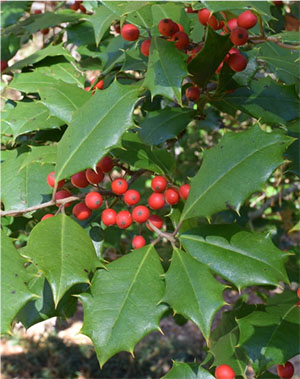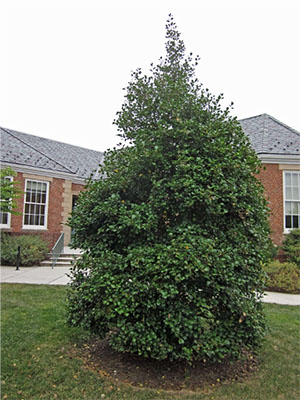Ilex opaca: American Holly
 Latin name: Ilex opaca
Latin name: Ilex opaca
Common name: American Holly
Flowers: Dull green to creamy white inconspicuous flowers bloom in spring 15
Fruit or cones: Round, shiny, bright red, fleshy drupe, ¼ in. long ripens in fall15
Height & Width: Height: 40-60 ft., width: 10-20 ft.13
Type: Tree, shrub, evergreen19
Habit: Open, pyramidal13
Wetland indicator category**: FAC, FACU17
Texture: Medium15
Growth rate: Slow19
Light: Full sun to part shade12
Moisture: Dry to wet moisture, low to medium drought tolerance10
Soil*: Moist, well-drained, sandy, sandy loam, medium loam, acidic pH < 6.810
Zones: 5-912
Origin: East, mainly Southeast United States16
Ecosystem benefits: Host plant for the Henry's Elfin butterfly, provides nectar for adult butterflies and other insects, fruits are eaten by songbirds, wild turkeys, quail, white-tailed deer, squirrels and other small mammals, honeybees are attracted to its tiny white flowers, provides cover during the winter13
 Features: Evergreen winter interest19, colorful fruit ornamental interest15, many ecosystem benefits for insects, birds, and mammals13.
Features: Evergreen winter interest19, colorful fruit ornamental interest15, many ecosystem benefits for insects, birds, and mammals13.
Siting: Street tree, courtyard tree, framing tree, specimen, barrier planting, or screen15.
Care: Plant so root flare is visible at soil surface14. At planting, water the root ball daily with two gallons of water per inch of trunk diameter for two weeks, every other day for two months and then weekly until established. Modify water recommendations to reflect site drainage and rainfall. Apply 3” of mulch over the planted area. Do not allow mulch to touch the trunk14. Can be trained as a hedge, bush, or tree19.
Pests: Holly leaf miner, scales, spider mites15.
This plant does not appear on the following invasive plant lists on 3/1/2020:
USDA SC Invasive Plant Species
SC Exotic Plant Pest Council
Author: Eric Thorogood
Image source:
https://gnps.org/plants/american-holly-ilex-opaca/
https://mgnv.org/2019/12/27/tree-ilex-opaca-american-holly-berries/
Sources:
- Armitage, A. (2001). Armitage’s manual of annuals, biennials, and half-hardy perennials. Portland, OR: Timber Press.
- Armitage, A. (2006). Armitage’s native plants for North American gardens. Portland, Oregon: Timber Press.
- Armitage, A. (2008). Herbaceous perennial plants: A treatise on their identification, culture, and garden attributes. Athens, GA: University of Geogia.
- Clemson Cooperative Extension Home and Garden Information Center.(2011). Flowers fact sheets. Retrieved from https://hgic.clemson.edu/category/flowers/
- Clemson Cooperative Extension Home and Garden Information Center.(2011). Groundcovers & vines fact sheets. Retrieved from https://hgic.clemson.edu/category/groundcovers/
- Clemson Cooperative Extension Home and Garden Information Center.(2011). Trees. Retrieved from https://hgic.clemson.edu/category/trees/
- Clemson Cooperative Extension Home and Garden Information Center.(2011). Shrubs. Retrieved from https://hgic.clemson.edu/category/shrubs/
- Dirr, M. A. (2009). Manual of woody landscape plants. Champaign, IL: Stipes Publishing.
- Gilman, E. F. (1997). Trees for urban and suburban landscapes. Albany, NY: Delmar Publishers.
- Lady Bird Johnson Wildflower Center University of Texas at Austin. (2012). Native plant information network. Retrieved from http://www.wildflower.org/explore/
- McMillan, P., Plant taxonomist Clemson University, personal communication.
- Missouri Botanical Garden Kemper Center for Home Gardening. Plant finder. Retrieved from http://www.mobot.org/gardeninghelp/plantfinder/Alpha.asp
- North Carolina State University (2005). Plant fact sheets. Retrieved from http://www.ces.ncsu.edu/depts/hort/consumer/factsheets/index.html
- Strother, E. V., Ham, D. L., Gilland, L. (2003) Urban tree species guide: Choosing the right tree for the right place. Columbia, SC: South Carolina Forestry Commission.
- University of Florida, IFAS Extension. (2011). Southern trees fact sheet. Retrieved from http://edis.ifas.ufl.edu/department_envhort-trees
- USDA. Plant profile. (n/d).Retrieved from http://plants.usda.gov/java/
- USDA. Plant wetland indicator status. (n/d). Retrieved from http://plants.usda.gov/wetland.html
- Vincent, E., Environmental horticulturist Clemson University, personal communication.
- Clemson Extension. Carolina Yards Plant Database. Retrieved from https://www.clemson.edu/extension/carolinayards/plant-database/index.htm
*Soil pH is determined using a professional soil test. Contact your Clemson University County Extension service for assistance www.clemson.edu/extension/. Click on “local offices”.
**2012 Plant Wetland Indicator categories (quantitative derived) http://plants.usda.gov/wetinfo.html
| Indicator Code | Indicator Status | Comment |
|---|---|---|
| OBL | Obligate Wetland | Almost always is a hydrophyte, rarely in uplands |
| FACW | Facultative Wetland | Usually is a hydrophyte but occasionally found in uplands |
| FAC | Facultative | Commonly occurs as either a hydrophyte or non-hydrophyte |
| FACU | Facultative Upland | Occasionally is a hydrophyte but usually occurs in uplands |
| UPL | Obligate Upland | Rarely is a hydrophyte, almost always in uplands |
